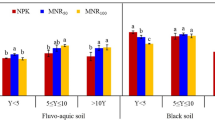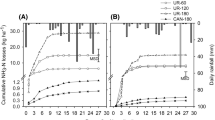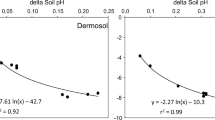Abstract
Vertisols are an important natural resource, particularly in the developing world, but a greater understanding of their chemical characteristics with special reference to the fate of applied N is needed for their greater sustainable use. The Bejucal clay (Chromic Dystraquerts, very fine, mixed, acid) is an important agricultural soil in North Trinidad and a series of studies were undertaken on it to determine the optimum rate and the best time of application and to quantify the efficiency of applied N using CO(NH2)2-15N and taro, commonly called dasheen locally, (Colocasia esculenta var. esculenta), as a test crop.
The optimum rate was found to be 280 kg N ha-1 for corm production from a field experiment, laid out in a randomised incomplete block design. This corresponded to an apparent recovery at 10 per cent when CO(NH2)2 was applied at 14 days after planting (DAP). Generally, a decrease in N uptake with increasing levels and later application times was observed. Another field experiment which employed 15N applied at 14, 56, and 112 DAP showed that 15applied at 112 DAP corresponded to the highest 15N level in the plant tissue.
A green house experiment conducted to determine the efficiency of the use of the applied N showed the highest recovery of approximately 49 per cent at a rate equilavent to 280 kg N ha-1 with efficiencies of 43 and 40 per cent at the 140 and 420 kg N ha-1 of applied N levels, respectively. A single application at 14 DAP resulted in an efficiency of 41 per cent compared to 44 and 47 per cent for the 2 split and 3 split applications, respectively. Split applications increased N uptake but without a corresponding increase in yield.
These studies showed that N applied as CO(NH2)2 at 280 kg N ha-1 at 14 DAP is optimum for upland taro production under conditions of the Bejucal clay. Under normal field conditions surface washing may be the most important N loss pathway but when excessive fertilizers are used then the gaseous pathways may also contribute to N losses.
Access this chapter
Tax calculation will be finalised at checkout
Purchases are for personal use only
Preview
Unable to display preview. Download preview PDF.
Similar content being viewed by others
References
Ahmad N (1983) Vertisols. In: Wilding LP, Smeck NE & Hall GF (eds). Pedogenesis and Soil Taxonomy II. The Soil Orders. Developments in Soil Science IIB, pp 91–123. Elsevier, Amsterdam, The Netherlands.
Barrie A (1991) New methodologies in stable isotope analysis. In: Stable istopes in Plant Nutrition, Soil Fertility and Environmental Studies. Proceeding of a Symposium, Vienna, October 1–5, 1990, pp 3–26. IAEA, Vienna, Austria.
Chapman T (1964) A note on the measurement of leaf area of the Tannia (Xanthosoma sagittifolium). Trop Agric (Trin). 41: 351–352.
Chesney HAD (1967) Denitrification in some Trinidad Soils. M Sc Thesis, Department of Soil Science, UWI, St. Augustine, West Indies.
De la Pena RS & Plucknett DL (1967) The response of taro (Colocasia esculenta L. Schott) to NPK fertilization in Hawaii. In: Symposium of the International Society of Tropical Root Crops, 1st, St. Augustine, 1967. Proceeding, pp 70–85. University of the West Indies, St. Augustine, West Indies.
Fullerton TP (1990) Volatilization of ammonia from urea in contrasting Trinidad Soils. Ph D Thesis. Department of Soil Science, UWI, St. Augustine, West Indies.
Hardy F (1946) Seasonal fluctuations of soil moisture and nitrate in a humid tropical climate (Trinidad, B.W.I.). Trop Agric (Trin) 23: 40–49.
Igobokume MC & Ogbannaya JC (1980) Yield and Nitiogen uptake by cocoyam as affected by nitrogen application and spacing. In: Terry ER et al. (ed), Tropical Root Crops: Research Strategies for the 1980s, pp 255–258. IDRC, 1981.
Myrold DD & Tiedje JM (1985) Diffusional constraints on denitrification in soil. Soil Sci Soc Am J 49: 651–657.
Ramnanan N (1993) Use of Urea on dasheen (Colocasia esculenta van esculenta) in an acid Vertisols of Trinidad. M. Phil, thesis, Soil Science Department, U.W.I. Trinidad.
Sivan S (1980) Review of Taro research and production in Fiji. In: Chandra S (ed), Edible Aroids, pp 52–63. Oxford Univ. Press, Oxford, UK.
Author information
Authors and Affiliations
Editor information
Editors and Affiliations
Rights and permissions
Copyright information
© 1995 Kluwer Academic Publishers
About this chapter
Cite this chapter
Ramnanan, N., Ahmad, N., Griffith, S.M. (1995). Fate of CO(NH2)2-15N applied to taro (Colocasia esculenta var. esculenta) in an acid Vertisol of Trinidad. In: Ahmad, N. (eds) Nitrogen Economy in Tropical Soils. Developments in Plant and Soil Sciences, vol 69. Springer, Dordrecht. https://doi.org/10.1007/978-94-009-1706-4_10
Download citation
DOI: https://doi.org/10.1007/978-94-009-1706-4_10
Publisher Name: Springer, Dordrecht
Print ISBN: 978-94-010-7264-9
Online ISBN: 978-94-009-1706-4
eBook Packages: Springer Book Archive




